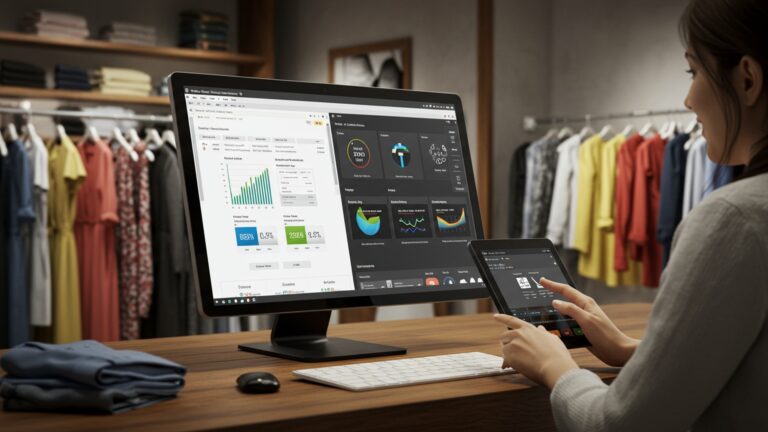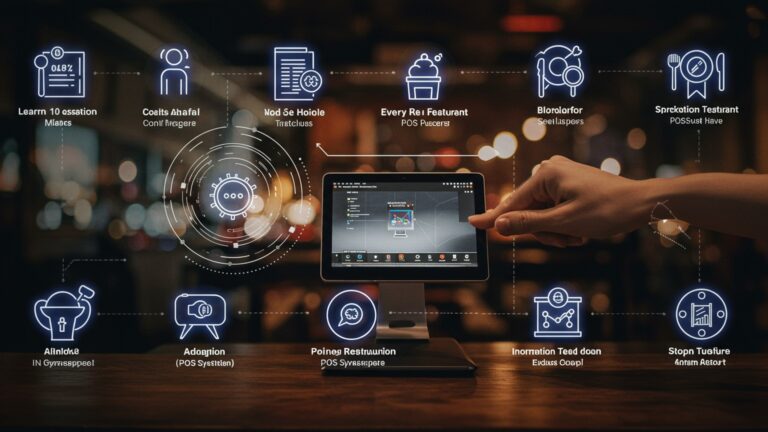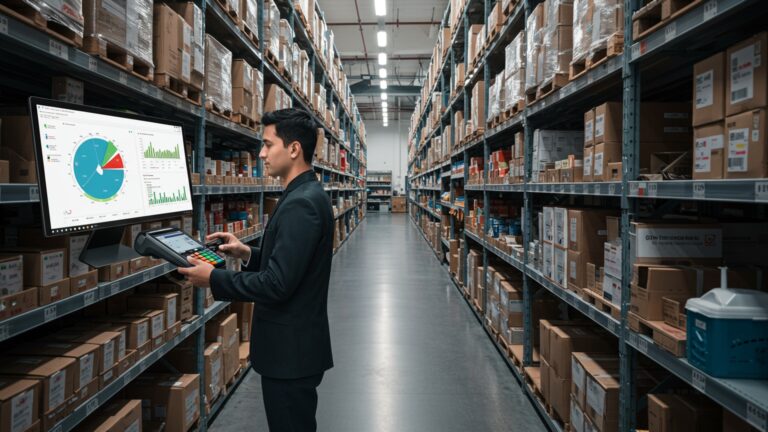Learn 6 Simple Steps to Master Restaurant POS Inventory Management
Restaurants grapple daily with the silent drain of inefficient inventory management, often losing significant profits to food waste and stockouts. Mastering this critical operational aspect transcends simple counting; it demands a strategic approach leveraging advanced technology. Modern Restaurant POS software transforms how kitchens operate, providing real-time data to meticulously track everything from incoming produce shipments to predicting demand for high-value items like premium seafood or artisanal bread. This proactive system prevents costly spoilage, minimizes over-ordering. ensures popular dishes never unexpectedly run out, directly impacting customer satisfaction and bottom-line profitability. You gain unparalleled precision, moving beyond manual spreadsheets to strategic, data-driven control over your most valuable culinary assets.
Understanding the Core: What is Restaurant Inventory Management?
At its heart, restaurant inventory management is the systematic process of ordering, storing, tracking. utilizing all the ingredients and supplies a restaurant needs to operate. It encompasses everything from the fresh produce and meats in your walk-in cooler to the napkins, cleaning supplies. liquor bottles behind the bar. Effective inventory management is not merely about knowing what you have; it’s about optimizing your stock levels to reduce waste, control costs. ensure you always have what you need to serve your customers.
Historically, this process was a laborious, often manual task involving clipboards, spreadsheets. countless hours spent counting items. But, the advent of specialized Restaurant POS software has revolutionized inventory management, transforming it from a chore into a strategic advantage. This software integrates sales data with stock levels, providing real-time insights that were previously unattainable. Without robust inventory management, a restaurant risks overstocking (leading to spoilage and tied-up capital) or understocking (resulting in missed sales and frustrated customers). It directly impacts your bottom line, profitability. operational efficiency.
The Foundation: Digitizing Your Inventory Database
The first crucial step to mastering inventory is transitioning from any manual system to a digital database, ideally within your Restaurant POS software. This digital shift provides a centralized, accessible. accurate record of every item your restaurant handles. Think of it as building the DNA of your inventory.
Here’s how to approach this foundational step:
- Item Setup
- Key Data Points
- SKU (Stock Keeping Unit)
- Vendor data
- Unit Cost
- Par Levels
- Measurement Units
- Recipe Management
Begin by meticulously listing every single ingredient and supply. This includes raw ingredients (e. g. , a specific type of tomato, a cut of beef), prepped items (e. g. , diced onions, house-made sauce). non-food items (e. g. , disposable gloves, cleaning solution).
For each item, input critical data:
A unique identifier for each item.
Who supplies the item, including contact details and order codes.
The precise cost per unit (e. g. , cost per pound of chicken, cost per bottle of wine).
The minimum quantity of an item you want to have on hand at any given time (we’ll delve deeper into this later).
How the item is purchased (e. g. , case, pound, gallon) versus how it’s used (e. g. , ounce, gram, individual item).
A powerful feature of modern Restaurant POS software is its ability to link individual menu items to their component ingredients. For instance, if you sell a “Signature Burger,” the POS should know that selling one burger deducts one bun, one patty, two slices of cheese, 0. 5 oz of special sauce, etc. This detailed breakdown is essential for accurate inventory depletion.
Real-world application: Imagine a small Italian bistro, “Luigi’s Pasta Palace.” Luigi’s used to track pasta, sauce. cheese on paper. When they implemented a new POS system, they painstakingly entered every ingredient for every dish. Now, when a customer orders the “Spaghetti Bolognese,” the system automatically deducts the precise amount of spaghetti, ground beef, tomatoes. herbs from their inventory. This upfront effort saves countless hours and prevents stockouts later.
Tracking Inbound and Outbound: Purchases and Sales Integration
Once your digital inventory database is established, the next critical step is to accurately track the movement of goods – both incoming (purchases) and outgoing (sales and waste). This forms the dynamic core of your inventory system, ensuring your stock levels are always reflective of reality.
- Receiving Inventory
- Comparing the delivery against your original purchase order to ensure accuracy.
- Verifying quantities and quality of received goods.
- Entering the received items into the POS, which automatically updates your stock levels. This step is crucial for maintaining accurate stock counts and identifying discrepancies with supplier invoices.
- Sales Integration and Depletion
- Recipe Management in Action
- Portion Control
- Accounting for Waste and Spoilage
When a new shipment arrives from a supplier, it’s vital to “receive” these items into your Restaurant POS software. This process typically involves:
This is where the true power of Restaurant POS software shines. When a customer orders a dish or drink, the POS system doesn’t just process the payment; it also intelligently deducts the component ingredients from your inventory.
As discussed, if your POS knows a ‘Chicken Caesar Salad’ requires 6 oz of chicken, 2 oz of romaine, 1 oz of dressing. 0. 5 oz of croutons, selling one salad will automatically reduce those specific ingredient quantities.
This automated deduction reinforces portion control, as the system expects a certain amount to be used per dish. Deviations can quickly be flagged during inventory counts.
Inventory isn’t only depleted by sales. Spoilage, breakage, kitchen errors. staff meals also reduce stock. A robust POS system allows you to log these “waste” items, providing a complete picture of your inventory movement and helping identify areas for improvement. For example, if you consistently find high levels of spoilage for a particular vegetable, it might indicate over-ordering or improper storage.
Use Case: Consider “The Daily Grind,” a busy coffee shop. When their barista makes a latte, the Restaurant POS software automatically subtracts a specific amount of espresso, milk. syrup from inventory. When a new shipment of coffee beans arrives, the manager inputs the delivered quantity. the system updates the stock. This seamless integration means the manager always knows how much coffee, milk. syrup they have, preventing last-minute rushes to the store or running out during peak hours.
Regular Audits and Stock Counts: Ensuring Accuracy
Even with the most sophisticated Restaurant POS software, physical inventory counts remain an indispensable part of inventory management. Technology streamlines the process. human verification ensures the digital records align with reality. Discrepancies can arise from spoilage, breakage, theft, incorrect data entry, or supplier errors.
- The Importance of Physical Counts
- Identify missing or unaccounted-for items.
- Pinpoint areas of high waste or potential theft.
- Correct data entry errors.
- Gain a true understanding of your cost of goods sold (COGS).
- Cycle Counting vs. Full Inventory
- Cycle Counting
- Full Inventory
- Leveraging Technology for Counting
- Reconciling Discrepancies
- Data Entry Errors
- Spoilage/Waste
- Theft
- Portion Control Issues
- Unaccounted for Use
Regularly comparing your physical stock to what your POS system reports is critical. This process, often called a “stocktake” or “audit,” helps you:
Instead of counting everything at once, cycle counting involves counting a small, specific subset of inventory items on a rotational basis. For example, you might count all produce on Mondays, all dairy on Tuesdays. all dry goods on Wednesdays. This method is less disruptive, allows for more frequent checks on high-value or fast-moving items. helps identify issues continuously.
This involves counting every single item in your inventory, typically done monthly or quarterly. While more time-consuming, it provides a comprehensive snapshot of your entire stock and is often required for financial reporting.
Modern Restaurant POS software often comes with features or integrates with handheld devices (scanners, tablets) specifically designed for inventory counting. These tools allow staff to quickly scan barcodes or input quantities, which then automatically update the system and highlight discrepancies. This significantly reduces manual errors and time spent on data entry.
When a physical count doesn’t match the POS record, it’s crucial to investigate the cause. Common reasons include:
Incorrectly receiving items or not logging waste.
Items expiring, being dropped, or improperly stored.
Internal or external.
Over-portioning by kitchen staff.
Staff meals not logged, missing free samples.
Addressing these discrepancies promptly can lead to significant cost savings and improved operational integrity.
Example: Sarah, the owner of a bustling sandwich shop, performs weekly cycle counts on her most expensive ingredients like specialty meats and cheeses. Her Restaurant POS software allows her to quickly pull up the expected quantity and input the actual count. Last week, she noticed a consistent discrepancy in avocado stock. Upon investigation, she discovered a new prep cook was using two whole avocados per sandwich instead of the standardized one and a half. By identifying and correcting this, she immediately saved significant ingredient costs.
Leveraging Data for Smart Decisions: Reporting and Analytics
The true power of integrating inventory management with Restaurant POS software lies in its ability to generate insightful reports and analytics. This data transforms raw numbers into actionable intelligence, allowing you to make informed decisions that boost profitability and efficiency. Without data analysis, you’re essentially operating blind.
- Key Inventory Reports
- Inventory Valuation Report
- Cost of Goods Sold (COGS) Report
- Variance Reports
- Waste Reports
- Usage Reports
- Identifying Trends and Optimizing
- Slow-Moving vs. Fast-Moving Items
- Optimizing Ordering Quantities
- Vendor Performance
Your POS system should be capable of generating a variety of reports, each offering a unique perspective:
Shows the total monetary value of your current stock. Essential for financial reporting and understanding capital tied up in inventory.
Calculates the direct costs attributable to the production of the goods sold by your restaurant. This is a crucial metric for understanding profitability.
Highlights discrepancies between theoretical (POS-recorded) and actual (physical count) inventory levels. These are your red flags for waste, theft, or operational inefficiencies.
Detailed breakdown of items written off due to spoilage, breakage, or errors. Helps identify problem areas and training needs.
Shows how much of each ingredient is being used over a specific period.
Reports can easily show which ingredients are flying off the shelves and which are sitting idle. This helps optimize ordering and menu planning. Perhaps a dish that uses a slow-moving, expensive ingredient needs to be re-evaluated.
By analyzing historical sales data and current inventory levels, you can make more accurate forecasts, reducing the risk of over-ordering (and subsequent waste) or under-ordering (leading to lost sales).
Consistent discrepancies in received goods or issues with quality, as highlighted by inventory reports, can inform decisions about vendor relationships.
Case Study: “The Fresh Plate,” a farm-to-table restaurant, started using its Restaurant POS software‘s analytics features to scrutinize their produce inventory. They noticed through variance reports that a particular seasonal vegetable consistently showed high spoilage. By cross-referencing with sales data, they realized that while popular, they were ordering too much at once. They adjusted their ordering schedule to smaller, more frequent deliveries, reducing waste by 15% and saving hundreds of dollars monthly. This data-driven decision was impossible before they embraced POS inventory analytics.
Optimizing and Automating: Setting Par Levels and Alerts
The final step in mastering restaurant inventory management is to move beyond mere tracking and into proactive optimization and automation. This is where your Restaurant POS software truly becomes a strategic partner, helping you predict needs and prevent problems before they arise.
- Defining and Calculating Par Levels
- What are Par Levels? A “par level” is the minimum quantity of an item you want to have on hand at any given time to meet expected demand until your next delivery. It’s your ideal stock level.
- How to Calculate
Par levels are calculated based on historical usage (from your POS reports!) , delivery frequency. lead time from suppliers.
Par Level = (Daily Usage x Delivery Frequency) + Safety Stock
For example, if you use 10 kg of flour daily, receive deliveries every 3 days. want a 1-day safety stock, your par level would be (10 kg 3 days) + 10 kg = 40 kg.
Many advanced Restaurant POS software systems can use your defined par levels, current inventory. sales forecasts to generate automated reorder suggestions. When an item’s stock falls below its par level, the system can automatically flag it or even generate a draft purchase order. This significantly reduces the manual effort of creating orders and ensures you don’t run out of critical ingredients.
Set up alerts within your POS system to notify you when:
- An item is approaching its par level (triggering a reorder).
- An item is nearing its expiration date (allowing staff to prioritize its use or discard it before it spoils).
- An item is completely out of stock (prompting immediate action).
These alerts prevent emergencies and allow for proactive management.
Some high-end Restaurant POS software offers direct integration with supplier ordering systems. This means generated purchase orders can be sent directly to your vendors, streamlining the entire procurement process and reducing errors.
Personal Anecdote: “Chef Maria’s Bistro” struggled with inconsistent inventory. Sometimes they had too much of an ingredient that spoiled, other times they ran out of a popular item during a busy dinner service. After implementing par levels and automated alerts within their Restaurant POS software, Maria saw a dramatic improvement. Her system now automatically suggests orders for her weekly produce delivery, ensuring she has enough fresh ingredients without overstocking. She recounts, “The biggest game-changer was the low-stock alert for our specialty olive oil. Before, we’d only realize we were running low when the bottle was almost empty. Now, the POS tells me days in advance, giving me time to order without panic. It’s reduced our waste by 20% and improved our consistency on the line significantly.” This level of automation allows restaurant owners and managers to focus more on their guests and less on manual inventory headaches.
Conclusion
Ultimately, mastering restaurant POS inventory management isn’t just about counting stock; it’s about strategic control that directly impacts your bottom line. By consistently applying the six steps we’ve outlined, you transform your inventory from a headache into a powerful asset. My personal tip? Treat every inventory count, whether daily spot checks or weekly full counts, as a direct conversation with your profit margins. This vigilance is crucial, especially with current trends leveraging AI-driven forecasting to minimize waste. Consider, for instance, how a precise inventory system prevents over-ordering expensive ingredients like fresh seafood, saving you from the dreaded 20% spoilage rate many establishments still grapple with. I’ve witnessed kitchens go from chaotic overstocking to perfectly lean operations simply by embracing their POS system’s full potential for tracking and ordering. This proactive approach, not just reactive counting, ensures you always have what you need without tying up excess capital. Embrace these practical methods, continually refine your processes. watch your restaurant not only survive but truly thrive through optimized efficiency and sustained profitability.
More Articles
How to Choose the Best POS System 5 Key Strategies for Restaurant Success
Discover 7 Essential Restaurant POS Features to Boost Your Business Efficiency
7 Essential Ways Restaurant POS Software Boosts Your Business Profitability
Are You Using Your Restaurant POS Software Effectively Discover 8 Smart Strategies
Mastering Restaurant Operations 10 Features Your POS Software Must Have
FAQs
What’s this guide about, really?
This guide breaks down how to get really good at managing your restaurant’s inventory using your Point-of-Sale (POS) system. It walks you through six simple, actionable steps to help you cut waste, save money. keep your kitchen running smoothly.
Why is solid inventory management so crucial for my restaurant’s success?
Good inventory management is vital because it helps you track every ingredient, prevent spoilage and theft, control your food costs. ensure you always have what you need for your menu. Ultimately, it directly boosts your profitability and operational efficiency.
Will these steps work with any restaurant POS system?
While the core principles are universal, the guide focuses on leveraging the inventory features commonly found in most modern restaurant POS systems. You might need to adapt the specifics slightly to match your particular software’s interface and capabilities. the concepts remain the same.
What kind of steps are included in the guide?
We cover practical steps like setting up your inventory items correctly in the POS, conducting regular and accurate stock counts, tracking waste and spoilage, understanding your sales data. using your POS reports to make smart ordering decisions. It’s all about making your POS a powerful inventory tool.
How quickly can I expect to see results after implementing these tips?
You can start noticing improvements in a few weeks, especially in areas like reduced waste and clearer stock levels. Achieving full mastery and significant cost savings usually takes a couple of months of consistent effort and fine-tuning. the benefits are definitely worth it.
Do I need to be a tech wizard to follow these inventory management steps?
Absolutely not! The guide is designed to be super user-friendly. While basic familiarity with your POS system is helpful, the steps are explained in plain language, focusing on practical application rather than complex technical jargon. Anyone can follow along.
What’s the biggest benefit of truly mastering POS inventory management?
The biggest benefit is a significant improvement in your restaurant’s profitability. By cutting down on waste, preventing over-ordering, optimizing your stock levels. having better control over your ingredients, you directly impact your bottom line and ensure your business runs much more efficiently.




